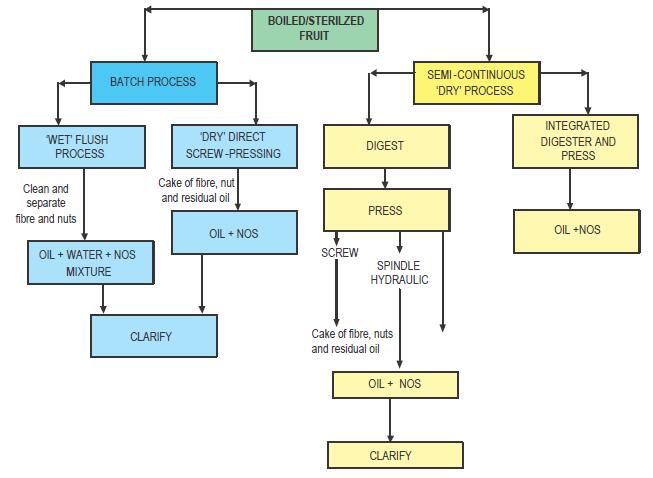In designing equipment for small-scale palm oil extraction one of the key factors to consider is the quality required. ‘Quality’ is entirely subjective and depends on the demands of the ultimate consumer. For the edible oil refining industry the most important quality criteria for crude oil are:
• low content of free
• low content of products of oxidation (which generate off-flavours);
• readily removed colour.
The most critical stages in the processing sequence for a processor seeking to satisfy these criteria are: bunch sterilization as soon as possible after harvest; and effective clarification and drying of the crude oil after extraction.
By contrast, for the domestic consumer of crude palm oil, flavour is the primary quality factor. This is boosted by the fermentation that takes place within the fruit when the bunches are allowed to rest for three or more days after harvesting. Thus sterilization immediately after harvesting is not a crucial consideration. Herbs and spices for flavour are introduced during the oil-drying phase of operations to mask off-flavours. Therefore rigid process control during oil clarification need not be prescribed or incorporated in the design.
The free fatty acids and the trace tocopherols contained in the crude palm oil after natural fermentation also have a laxative effect, which is desirable for African consumers for whom synthetic substitutes are a luxury. The acidity imparts a ‘bite’ to the oil which some consumers prefer. Thus the quality requirements of one market, leading to certain processing imperatives, may conflict with those of another market.
The traditional manual methods are normally referred to as ‘low technology’ production. The mechanised units are likewise referred to as ‘intermediate technology’ production.
The village traditional method of extracting palm oil involves washing pounded fruit mash in warm water and hand squeezing to separate fibre and nuts from the oil/water mixture. A colander, basket or a vessel with fine perforated holes in the bottom is used to filter out fibre and nuts. The wet mixture is then put on the fire and brought to a vigorous boil. After about one or two hours, depending on the volume of material being boiled, the firewood is taken out and the boiled mixture allowed to cool. Herbs may be added to the mixture at this point just before reducing the heat. On cooling to around blood temperature, a calabash or shallow bowl is used to skim off the palm oil. Because of the large quantities of water used in washing the pulp this is called the ‘wet’ method.
A mechanical improvement, based on the traditional wet method process, is achieved by using a vertical digester with perforated bottom plate (to discharge the aqueous phase) and a side chute for discharging the solid phase components. The arrangement combines digestion, pressing and hot water dilution into one mechanical unit operation.
The ‘dry‘ method uses a digester to pound the boiled fruit, which is a considerable labour-saving device. The oil in the digested or pounded pulp is separated in a press that may be manual or mechanical. Motorised mechanical presses are preferred, whether hydraulic or screw type.
Most medium- and large-scale processing operations adopt the ‘dry‘ method of oil extraction. This is because the fibre and nut shells may immediately used to fire the boiler to generate steam for sterilization and other operations, including electricity generation. If the huge volumes of fibre and shells are not used as boiler fuel, serious environmental pollution problems may result. Too much water in the fibre increases the amount and cost of steam required to dry the fibre. Hence the preference for the dry method in plants handling more than six tonnes FFB per hour.
Processing machinery manufacturers tend to make machines to fit individual processing operations. However, recent developments have been toward the manufacture of integrated machines, combining several process operations such as digestion, pressing and fibre/nut separation into one assembly. It is found that these machines fit into two key process groupings: batch and semi-continuous processes.
Schematic of processing models and associated machinery

NB: NOS = Non-oily solids entrained in oil such as coagulated protein, gums and resins, etc.
The extraction of palm oil from boiled palm fruit can be accomplished by handling successive batches of materials or continuously feeding material to the machines.
